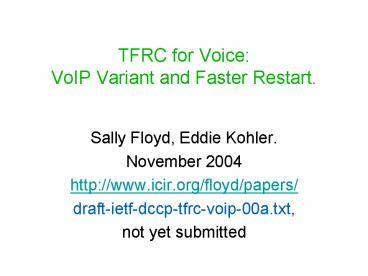TFRC for Voice: VoIP Variant and Faster Restart. PowerPoint PPT Presentation
Title: TFRC for Voice: VoIP Variant and Faster Restart.
1
TFRC for VoiceVoIP Variant and Faster Restart.
- Sally Floyd, Eddie Kohler.
- November 2004
- http//www.icir.org/floyd/papers/
- draft-ietf-dccp-tfrc-voip-00a.txt,
- not yet submitted
2
Issues for VoIP traffic
- Small packets
- Fairness in packets per second (pps) or in bytes
per second (Bps)? - Measuring congestion
- Packet loss rates or loss event rates?
- Restart after idle
- Faster Restart.
- Next steps.
3
VoIP fairness in Bps.
- Standard TFRC has the goal of fairness in pps
with TCP flows using the same packet size. - The VoIP variant of TFRC has the goal of fairness
in Bps with TCP flows using 1500-byte packets,
(following RFC 3714). - The VoIP variant assumes optimistically that the
network limitation is in Bps, not in pps.
4
VoIP fairness in Bps.
- In the TCP throughput equation, use the measured
loss event rate and a packet size of 1460 bytes. - Reduce the allowed transmit rate to account for
the fraction of the VoIP bandwidth that would be
used by 40-byte headers - X lt- X TruePktSize/(TruePktSize Header)
- TruePktSize average segment size in bytes
- Header 40 bytes
- Enforce a Min Interval between packets of 10 ms.
5
TFRC only
6
Standard TFRC (bottom) and TCP (top)
7
VoIP TFRC (bottom) and TCP (top)
8
Measuring Congestion
- The VoIP variant of TFRC uses the loss event
rate. - RFC 3714 uses the packet drop rate.
- These are both affected by packet size and by the
smoothness of the sending rate. - The effect of packet size on the packet drop rate
could use more investigation.
9
Measuring Congestion
- Packet size in a Drop-Tail world
- Queue measured in bytes, packets, or in-between?
- Smooth or bursty sending rates?
- High or low levels of statistical multiplexing?
- RED in packet mode
- Same packet drop rate for big and small packets.
- TFRC measures the loss interval in packets.
- RED in byte mode
- Same byte drop rate for big and small packets.
10
The VoIP variant of TFRC
- As it stands now, it sometimes favors the VoIP
TFRC flow over the large-packet TCP flow. - This needs to be quantified and evaluated.
11
Faster Restart after Idle
- The motivation
- The sender knows more after an idle period that
it does when just starting up. - So it should be able to be more aggressive than
the default slow-start.
12
Faster Restart after Idle
- CCID 3 says not to reduce the sending rate below
4 packets per RTT because of an idle period. - Change this to 8 packets, or at most 4KB.
- Quadruple instead of double the sending rate each
RTT. - Up to the old sending rate.
- Allow this just for VoIP TFRC flows restricted to
at most one packet per 10 ms? - Or allow this for any TFRC flow?
13
The next step
- Allow TFRC flows to send more than twice the
reported receive rate under other circumstances,
if - Allowed by the allowed sending rate, and
- That rate has been successfully sustained in the
past, and - There has been no congestion in the recent past.
- Justification You know more than a blank slate,
so you should be able to be more aggressive than
slow-start.
14
The state of TFRC in NS
- Includes the VoIP variant.
- Includes RFC 3390 initial sending rates.
- More updating is needed.
- Add RFC 3390 sending rates after idle periods.
- Add Faster Restart.
- Add overhead for packet headers.

